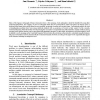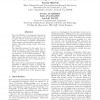142 search results - page 19 / 29 » Disambiguating Highly Ambiguous Words |
LREC
2008
13 years 9 months ago
2008
Many of the Japanese ideographs (Chinese characters) have a few meanings. Such ambiguities should be identified by using their contextual information. For example, we have an ideo...
ACL
2003
13 years 9 months ago
2003
We present a supervised machine learning algorithm for metonymy resolution, which exploits the similarity between examples of conventional metonymy. We show that syntactic head-mo...
ANLP
1992
13 years 8 months ago
1992
The real di culty in development of practical NLP systems comes from the fact that we do not have e ective means for gathering \knowledge". In this paper, we propose an algor...
CICLING
2007
Springer
14 years 1 months ago
2007
Springer
Distributions of the senses of words are often highly skewed. This fact is exploited by word sense disambiguation (WSD) systems which back off to the predominant (most frequent) s...
IJCAI
2007
13 years 9 months ago
2007
In this paper we revisit the classical NLP problem of prepositional phrase attachment (PPattachment). Given the pattern V −NP1−P −NP2 in the text, where V is verb, NP1 is a ...


